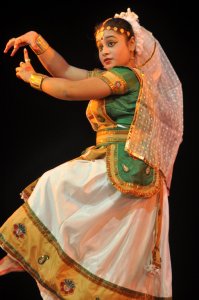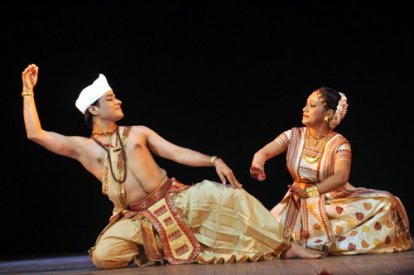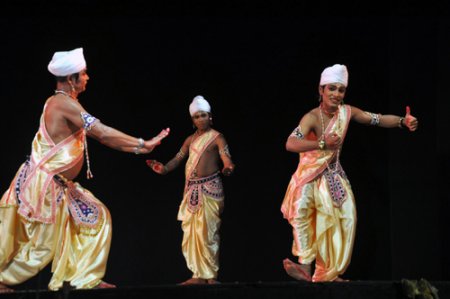
|   |

|   |
Sattriya Dances: 12th Nritya Parva Festival at Guwahati - Dr. Sunil Kothari e-mail: sunilkothari1933@gmail.com Photos courtesy: Manmarmi, Sattriya Kendra December 5, 2012 Established in 2008 as a Project under Sangeet Natak Akademi, Sattriya Kendra, Guwahati, has been carrying on the celebration of annual Nritya Parva since then. With Sattriya dance form of Assam getting recognition in 2000 as the 8th classical dance form on par with other classical dance forms, there has been a gradual stream of young boys and girls studying Sattriya and performing it regularly within Assam and also outside Assam in major metropolitan cities in India and some of them have also been performing abroad. The 12th edition for four days from 15th till 18th November 2012 saw various dancers including group dances of Gayan Bayan from traditional Sattras (monasteries) from different parts of Assam performing at Rabindra Bhawan in the evening. Each participant is allotted 30 minutes and by 8pm the program is over. Raju Das, project secretary, with recommendations of the committee members of Sattriya Kendra, makes selection of artistes representing solos, duets, trios and group performances, which cover the range of Sattriya dance corpus. The Nritya Parva has been instituted since 2000 to bring to Guwahati, artistes from other cities and monasteries. Now the festival has acquired a prestigious status and showcases established and also up and coming artistes. The festival under review was inaugurated by Lalit Chandra Ojha from Mangadoi, Sangeet Natak Akademi awardee and Sangeet Natak Akademi Tagore Fellow senior guru for Ojapali dances. The opening day From Titabar, Jorhat District, Gayan Bayan artistes of Kamalabari Sattra Kristi Prachara Samiti led by Paramananda Kakoti Barbayan gave a well choreographed presentation of playing upon khol and tala, large brass cymbals, weaving various patterns, sitting, moving in a circle and using various nritta hastas. Kamalabari Sattra has a great reputation of maintaining the tradition handed over by legendary masters. The present generation of celibate monks is maintaining the standard tailoring the performance to suit modern sensibilities without compromising the spirit of devotion.
Guru Ghanakanta Bora Barbayan has trained his daughter Sanghamitra Bora from a very young age in traditional dances. Dance is in her blood and under her father's guidance, she is making commendable progress. In Krishnavandana of Madhavadeva, devotional mood was projected well. Ghanakanta Bora had specially choreographed for Sanghamitra from the 8th canto of Bhagavtapurana by Sankaradeva, the Matsyavatara episode. It was performed with dramatic approach. There were renderings of spoken dialogue. In Chali, pure dance number, Sanghamitra displayed graceful movements to Thukoni and Chuta tala. She is a bright disciple and will go places. The highlight of the evening was a duet by Naren Chandra Boruah and Anita Sharma, whose selection of dance numbers was artistic, innovative and highly professional. After the usual prayer, with excellent image of Sheshashayi Vishnu and Lakshmi pressing his feet, each one danced a pure dance number exploring tala and layakari, displaying their command over nritta. However, the piece de resistance was the story of Kubja, the woman with a hunch back, who worshipped Lord Krishna. She prepares sandal paste to offer to Lord Krishna and the Lord obliges her and turns her into a beautiful woman removing her hunch back. The synchronized movements were eye catching, as both are seasoned dancers. The finale could be edited without dance with small cymbals. That would make the dance number effective. Music accompaniment by Bhaskar Jyoti Ojha, vocal by Prashanta Rajkhowa and others added to its dramatic impact.  Sanghamitra Bora  Naren Chandra Boruah and Anita Sharma Under Sattriya Kendra's training project from Barpeta under the guidance of Guru Guruprasad, the young monks presented Sattriya Ojapali dwelling upon story of Krishna's Lila. Yashoda's vatsayla for child Krishna, Dadhimathana, Krishna climbing Kadamba tree etc., were enacted with involvement. The Pali (main singer) and Dayana Pali (the singer on the right), two young trainees, drew attention for their singing and acting. It was heartening to see the trainees making progress under the present scheme. Kalabhumi, Majuli presented Vadya khayali which explored Vaishnava literature known as Tutoi, dealing with the glory of Krishna. The final group dance choreographed by Muhikanta Bayan of Uttar Kamalabari Sattra, with female dancers attired in men's costume gave good account of their dance, describing the playing upon various instruments like dundubhi, mridanga, morchang and others.
The second day The opening was of Gayan Bayan. Janji Moransinga Mridangia Dal from Sivasagar wears different colourful headgear and plays mridanga in place of khol. The sound texture is different, choreographic movements have circular, anti circular and one line patterns, along with tala players interweaving creating interesting visuals. It was an impressive presentation, bringing within its fold variation. In solo, Dreamly Gogoi, a disciple of Govinda Saikia and at present studying under Ghanakanta Bora, besides a prayer, performed story of Ahalya. Gautama rishi's curse turning her into a stone and Indra for his sin of seducing Ahalya, cursed to have thousand genitals on his body, had dramatic touches. Ahalya is redeemed by assurance that when Lord Rama's feet will touch her, she will be absolved from the curse. Dreamly performed with exaggerated abhinaya, which if controlled would be more effective. Also she needs to pay attention to removing rough edges of her pure dance. Guru Sailen Saikia's two young disciples Chandan Konwar and Mrinayani Deka gave a good account of their training in a brief duet recital. Their appearance was pleasant and pure dance commendable. Full of devotion, the prayer had depiction of ten incarnations. They deserve more opportunities as they have good potential. Jadav Hazarika, celibate monk from Kamalabari Sattra, Titabar, is a well trained male dancer. Under the guidance of Guru Manik Barabayan, he performed the episode of Krishna's vanquishing demons like Dhenukasura and others. Jadav is energetic and in Mati Akharas (ground exercises) he displayed energy with a spring in his feet while taking jumps. But he needs to exercise restraint for artistic presentation. The group dance by young female dancers from Nrityalaya, Sivasagar, was noteworthy for choreographic touches. Established in 2003, Nrityalaya trains dancers in Sattriya and Kathak also. The five young female dancers performed with zest and their enactment of episodes from Ramayana, monkeys building the bridge across ocean, Rama killing Ravana and group compositions were presented in an interesting manner. The third day The opening Gayan Bayan number was by Pathalipahar Sanmilita Natya Samaj, Lakhimpur, established in 1981 by late Bhaben Kumar Saikia. The standard of these artistes is customarily of high standard as they perform and practice as a part of ritual. The expertise of Gayan and Bayan parties is often seen in their use of hastas while playing upon drums and the gayan who join them in choreographic patterns. Aparajita Dawka, trained by Ghanakanta Bora under the scheme of project support to Sattriya dance, in her solo, seemed a mature dancer both in nritta and abhinaya. Performing to Sanskrit shloka Shantakara bhujagashayanam, Aparajita evoked familiar iconographic images and with hastabhinaya depicted Krishna's meghavaranam shubhangam, Krishna's body, dark as cloud. The dramatic episode was from Rukmini Harana, in which the friends of Rukmini tease her for her awaiting beloved Krishna. The playfulness of the sakhis and Rukmini was enacted with appropriate expressions. The twist comes in the play when instead of Krishna, brother Rukmavira arrives and wants Rukmini to marry not Krishna but another warrior. Aparajita's expressions from joy to dismay were well projected. Directed by Hari Saikia Barbayan the excerpt was quite impressive. The trio performance by Baby Bora Bordoloi, Priyakshee Pujari and Tutumoni Kalita, from Pragati Sankritik Prasikhsna Bikas Kendra, Guwahati, was noteworthy for brief anecdotes from Krishnalila. Putanamoksha and Kaliyadamana were performed impersonating different roles among three dancers. Using the principle of natyadharmi, stylized ekaharya, dressed in one costume, the different roles looked interesting. The young dancers acquitted themselves well in whatever they danced. Praname Bhagavati and Meenakshi Medhi, two disciples from Guru Jibanjt Dutta's Natan Sattriya Academy, in their duet performance in male costumes offered a prayer to Lord Krishna with shloka Sundargopalam urvanamalam describing Krishna's beauty. The dramatic presentation from 'Ajamila Upakhyana' had poignant moments, when on his deathbed, Ajamila calls his son whose name is Narayana, addressing him aloud "Narayana…Narayana…" and Lord Vishnu comes to save him from the clutches of Yama, god of death. Though the events were performed in quick succession, the abhinaya was intense.  Haricharan, Atul and Ranjan
On account of other engagements, I could not attend the last day of the Nritya Parva and missed the seminar session in the morning when the learned scholar Dr. K.D. Goswami was to deliver the lecture on 'Possibility to depict the Vaishnava Literature in dance format.' The entire field of Sattriya dance tradition is like an ocean. I have been attending Nritya Parva for past five years and am involved in doing research for many years to complete the book on Sattriya dances of Assam for Marg Publications. I was promised that the paper would be sent to me. The first day of the seminar was in the form of a lecture by Guru Jatin Goswami who after an overview of Sattriya dances drew attention to the highlights of the dance form and its limitations. He also expressed his righteous anger at dancers not practicing enough, starting rehearsals only few days earlier when they are selected to perform for Nritya Parva, do not show unity, do not care for making the form suitable for stage presentation and appear lackadaisical. He stressed the need for excellent costume (aharyabhinaya), showing two dancers, one dressed as in monastery, male impersonating female roles and covering their heads with a scarf, and the other dancer in a present day well designed costume of silk with exquisite designs and patterns. He did not shy away from telling the need for glamour necessary to attract audiences for visual aesthetic appeal. I endorsed his views and also drew attention to the need for making music more pleasing to the ears. Guru Jatin Goswami used the terms 'drishti nandana' appealing to the eyes, for costumes and 'shruti nandana' appealing to the ears for music. We spoke of melodious music of Odissi dance, contribution of Bhubaneswar Mishra, Balakrushna Das, Kelubabu and the gradual progress made by Odissi in its classical avatara. Sattriya was also presented in All India Dance Seminar in 1958 along with Odissi. Odissi received classical status earlier and Sattriya much later. Jatin Goswami blamed gurus and dancers for their lack of initiative and inability to keep pace with changing times. What is performed in monasteries is in nature of ritual, whether there is an audience or not. But to bring it on metropolitan stage, the form needs certain innovations and must keep pace with changing times. He did not wish to give up the spirit of dance, but he insisted upon modification. Guru Manik Barbayan demonstrated a few steps. The grace and lightness were exquisite. Madhavi Puranam, executive editor of Nartanam quarterly from Hyderabad, said that when one sees Guru Manik Barbayan, one is spellbound by Sattriya movements and if it is because of the rigour and lifestyle of living in a monastery, then it should be reflected in dance of present day dancers both from monastery and metropolitan young generation, by imbibing the spirit and rigourous practice. Aruna Mohanty, disciple of late Guru Gangadhar Pradhan, at present Vice President of Odisha Sangeet Natak Akademi, was specially invited from Bhubaneswar, to give a lec-dem on 'Samrachana, choreography, a concept in Indian dance.' She demonstrated the various stages of Odissi dance, the confluence of many strands from Odiya culture, in costumes, ornaments, movements from allied forms like Chhau, Sahi jatra, the gradual development of dance patterns. Contribution of Gurus Kelucharan Mohapatra, Deba Prasad Das, Pankaj Charan Das, the legacy the dancers inherited and how they build their choreography upon that. She gave examples of her own works like Varsha, how when it turns into cyclone and tsunami causing devastation, she had deconstructed pallavi movements for various stages of rain, how taking one word 'Dekhibo para ashare' looking at Krishna's beauty, she used improvisation, enriched the meaning of stanzas and also danced, sang and gave all a glimpse into the rich heritage of Odissi. As a young exponent / choreographer, she emphasized that today the young generation meets each other, exchanges views, has healthy attitude, is not driven by a spirit of competition, but is willing to share insights and admires each other's work. The young generation is open to experimentation and drawing upon the training they have received from their gurus, able to build new works upon it. It was very heartening to see Aruna Mohanty articulate these ideas so clearly and show to all present why it is necessary to work in a spirit of cooperation and broad outlook. Former Vice Chancellor of Khairagarh University and renowned Kathak exponent Purnima Pande was invited from Lucknow to attend Nritya Parva and seminar. Tapati Chowdhurie, well known dance critic of The Statesman from Kolkata, Madhavi Puranam from Hyderabad and I as a member of Advisory Board of Sattriya Kendra from SNA, expressed our unhappiness at the poor attendance of young generation of dancers and missing an opportunity of benefitting from such learned discourses. This apathy on part of Assamese dancers, unfortunately, will not allow Sattriya to scale greater heights and be on par with other established dance forms. Dulal Roy, the veteran theatre director as a Project Director of Sattriya Kendra and Secretary Raju Das have been doing splendid work by organizing music seminars, Ankiya Nat Bhaona festival, and Nritya Parva. They have produced 'Rama Vijaya' play in a traditional format, and Gurudev Rabindranath Tagore's 'Chandalika' in Sattriya style, choreographed by Guru Jatin Goswami. One more production is in the pipeline based upon 'Ajamila Upakhyana' titled as 'Agyan Nivritti.' The Sattriya Kendra sends dancers to other cities and abroad, has undertaken publishing a major work by scholar Dr. Jagannath Mahanta on Sattriya, and is working round the year to see that the Sattriya project now is ready to be a full-fledged Sattriya Kendra on the lines of the constituent bodies of SNA like Kathak Kendra and Jawaharlal Nehru Manipuri Dance Academy. Already, a land has been purchased from the Government of Assam. In order to create more awareness, a two-day dance seminar on Sattriya dance with demonstrations, discussions and performances in the evenings is planned for next year in March 2013 in New Delhi. In January next year the annual Ankiya Nat Bhaona festival will be mounted on a specially designed stage in Guwahati to give a flavour of traditional way of presentation. Each year during the Nritya Parva, a well conceived exhibition of photographs from the archive of SNA is mounted which gives one an idea of the progress made by Sattriya dances since its recognition as a classical dance form. The photographs of SNA awardees including Sangeet Natak Akademi Tagore awards and Fellowship in 2011 are enough to showcase the latest development in Sattriya dances. An exhibition of books and DVDs published by Sangeet Natak Akademi is displayed in the foyer, offering discount of 40% and made accessible to public during Nritya Parva. The lighting, the entries, exits and presentation under the watchful eye of Dulal Roy places Nritya Parva Festival in a professional category. The timing is strictly observed and no groups exceed the allotted time. The booklet giving brief introductions of participants and account of work done by Sattriya Kendra is distributed to audiences. The announcements are made by professional comperes. What needs to be taken care of is announcement of each dance number prior to its presentation instead of description of all dance numbers in the beginning. It becomes confusing as one is unable to identify pure dance numbers announced. Since the program book does not include details of dance numbers, ragas and talas, the information remains incomplete. I am sure this could be improved upon in future. The dance festival over the last decade has made tremendous contribution towards generating a new outlook amidst the people for this significant tradition. A tradition which has been nurtured by monks for more than five hundred years in more than 600 sattras all over Assam is a great cultural legacy and its development through the agency of Sattriya Kendra is a major achievement on part of Sangeet Natak Akademi.  Dr. Sunil Kothari is a dance historian, scholar, author and a renowned dance critic. He is Vice President of World Dance Alliance Asia Pacific India chapter, based in New Delhi. He is honored by the President of India with Padma Shri, Sangeet Natak Akademi award and Senior Critic Award from Dance Critics Association, NYC. He is a regular contributor to www.narthaki.com, the roving critic for monthly magazine Sruti and is a contributing editor of Nartanam for the past 11 years. Post your comments Pl provide your name and email id along with your comment. All appropriate comments posted with name and email id in the blog will also be featured in the site. |